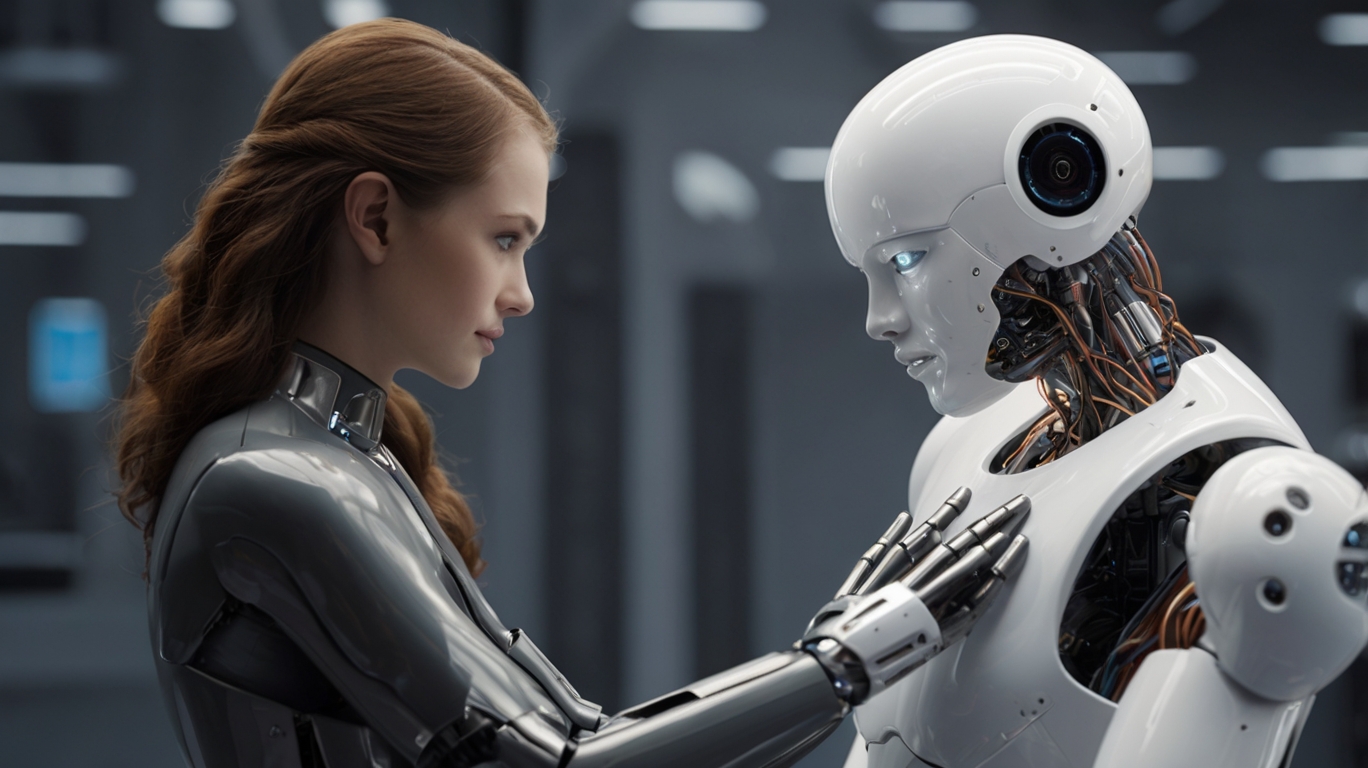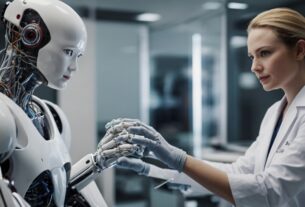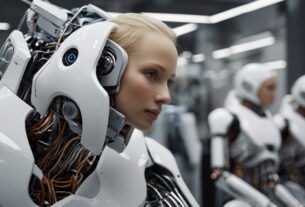The Future of Robotics:
Robotics has long been a field that captures the imagination, evoking images of futuristic cities, automated homes, and intelligent companions. Today, that future is no longer confined to science fiction. Robotics is becoming an integral part of our daily lives, influencing industries, healthcare, education, and even our homes. As intelligent machines continue to evolve, they promise to redefine our relationship with technology, work, and even with each other.
A Brief History of Robotics
To understand where robotics is headed, it helps to look back. The idea of automata dates back thousands of years, with early examples found in ancient Greek and Chinese civilizations. However, the modern age of robotics began in the 20th century. In 1961, Unimate, the first industrial robot, was installed at a General Motors plant. It revolutionized manufacturing by automating repetitive tasks with precision and efficiency.
Over the decades, robotics has advanced from simple mechanical arms to sophisticated machines powered by artificial intelligence (AI). Today, robots can perceive their environments, make decisions, and learn from experience. This progression has opened doors to applications far beyond the factory floor.
Intelligent Machines and Artificial Intelligence
At the heart of the robotics revolution is AI. Intelligent machines use AI to interpret data, recognize patterns, and adapt to new situations. Machine learning and neural networks enable robots to improve their performance over time without being explicitly programmed for every task.
Consider autonomous vehicles, for example. These self-driving cars rely on a combination of robotics and AI to navigate roads, avoid obstacles, and respond to traffic signals. Similarly, drones equipped with AI can perform complex tasks like surveying land, inspecting infrastructure, and even delivering packages.
The integration of AI also allows robots to work more collaboratively with humans. In manufacturing, collaborative robots or “cobots” assist human workers by handling dangerous or repetitive tasks. These cobots can sense human presence, adjust their movements, and learn new workflows, enhancing both safety and productivity.

Robotics in Healthcare
One of the most promising areas for robotics is healthcare. Robots are now performing delicate surgeries with incredible precision, often with fewer complications and faster recovery times for patients. Surgical robots, like the da Vinci Surgical System, allow doctors to operate through tiny incisions with enhanced control and visibility.
Beyond surgery, robots are transforming elder care and rehabilitation. Companion robots can monitor vital signs, remind patients to take medications, and even provide emotional support. In physical therapy, robotic exoskeletons help patients regain mobility by supporting and guiding their movements.
During the COVID-19 pandemic, robots played critical roles in disinfecting hospitals, delivering supplies, and conducting remote consultations. These applications highlighted the potential of robotics to improve healthcare access and resilience.
Robotics in Industry and the Workforce
Automation has long been associated with the fear of job displacement, but intelligent robotics is reshaping the workforce in more nuanced ways. Rather than replacing humans, many robots are augmenting human capabilities.
In warehouses, for instance, robots handle sorting and transporting goods, allowing human workers to focus on tasks that require judgment and dexterity. In agriculture, autonomous tractors and drones monitor crop health, optimize irrigation, and reduce pesticide use, increasing sustainability and yields.
Even in traditionally labor-intensive industries like construction, robots are beginning to take on tasks such as bricklaying, welding, and painting. These developments not only boost efficiency but also help address labor shortages and improve safety on job sites.
Education and Social Robotics
As robotics becomes more pervasive, educational institutions are integrating robotics into their curricula to prepare students for the future. Robotics programs teach coding, engineering, and problem-solving skills, fostering innovation and creativity from a young age.
Social robots, designed to interact with humans on an emotional level, are also making their way into classrooms and homes. These robots can assist children with learning disabilities, support language development, and even help teach social cues. Their ability to engage and respond empathetically is opening new avenues in special education and therapy.
The Ethics and Challenges of Intelligent Robotics
With great power comes great responsibility. The rise of intelligent robots raises complex ethical questions. How do we ensure that robots make fair and unbiased decisions? Who is accountable if a robot causes harm? What happens to privacy when robots collect data in our homes and workplaces?
There are also concerns about surveillance, dependency, and loss of human connection. As robots become more lifelike and autonomous, it’s crucial to maintain clear boundaries and prioritize human dignity. Transparent algorithms, robust safety standards, and inclusive design are essential for building trust and ensuring ethical use.
Moreover, global access to robotics technology is uneven. While advanced economies are rapidly adopting intelligent machines, many developing countries face barriers due to cost, infrastructure, and skills gaps. Bridging this digital divide is critical for ensuring equitable benefits from robotics advancements.
The Future Landscape of Robotics
Looking ahead, robotics is poised to become even more intelligent, autonomous, and integrated into our lives. Emerging technologies like quantum computing, bio-inspired design, and 5G connectivity will further expand what robots can do.
We can expect to see more personalized robots tailored to individual needs, from personal assistants to health monitors. In smart cities, robots may handle waste management, traffic control, and public safety. In space exploration, robots will continue to be our pioneers, conducting research and building habitats in environments too hostile for humans.
Interdisciplinary collaboration will play a key role in shaping this future. Engineers, ethicists, policymakers, and citizens must work together to navigate the opportunities and challenges of robotics. Public dialogue, education, and transparent governance will be vital for harnessing the benefits while mitigating risks.
Conclusion
The future of robotics is not a distant dream—it is unfolding before our eyes. Intelligent machines are transforming the way we live, work, learn, and heal. As robotics continues to evolve, it holds the potential to enhance human capabilities, solve pressing global challenges, and create a more connected, efficient, and compassionate world.
But realizing this potential requires thoughtful design, ethical foresight, and a commitment to inclusivity. By embracing robotics with curiosity, responsibility, and a human-centered approach, we can shape a future where technology truly serves humanity.
The Future of Robotics:
Frequently Asked Questions (FAQ) – The Rise of Intelligent Robotics
1. What is robotics and how is it impacting our daily lives?
Robotics is the design, construction, and use of machines (robots) to perform tasks traditionally carried out by humans. Today, robotics is transforming industries, healthcare, education, and homes—making processes more efficient, precise, and safe.
2. How has robotics evolved over time?
Early robotics began with simple automata in ancient civilizations. Modern robotics started with the 1961 invention of Unimate, the first industrial robot. Since then, the field has progressed to intelligent machines capable of learning, perceiving environments, and making decisions using AI.
3. What role does artificial intelligence play in robotics?
AI is the brain behind intelligent robots. It allows machines to interpret data, recognize patterns, and adapt to new situations through technologies like machine learning and neural networks. AI-powered robots can work autonomously and improve their performance over time.
4. Can you give examples of AI and robotics working together?
Absolutely. Self-driving cars use robotics and AI to navigate roads. Drones equipped with AI can inspect infrastructure or deliver packages. In factories, collaborative robots (cobots) work safely alongside humans, learning and adapting to different tasks.
5. How is robotics used in healthcare?
In healthcare, robots perform minimally invasive surgeries with extreme precision, aid in physical rehabilitation, monitor patient health, and provide companionship for the elderly. During COVID-19, robots also helped disinfect facilities and deliver medical supplies.
6. Will robots take over human jobs?
While automation can replace certain tasks, many robots are designed to augment human work—not replace it. For example, in warehouses and agriculture, robots handle repetitive or dangerous tasks, allowing humans to focus on more complex responsibilities.
7. How are robotics and education connected?
Robotics education teaches coding, problem-solving, and engineering skills from an early age. Social robots also assist in classrooms, especially for children with learning disabilities, by providing interactive and empathetic learning experiences.
8. What are the ethical concerns surrounding intelligent robotics?
Key concerns include:
- Ensuring fairness in AI decision-making
- Assigning accountability if robots cause harm
- Protecting privacy as robots collect data
- Preventing over-dependence and loss of human connection
Ethical robotics requires transparency, safety standards, and inclusive design.
9. Is access to robotics technology equal around the world?
No. While developed nations lead in robotics adoption, many developing countries face challenges due to high costs, limited infrastructure, and skill shortages. Bridging this digital divide is essential for global equity.
10. What does the future of robotics look like?
Future robots will be more intelligent, autonomous, and personalized. They’ll assist with urban management, healthcare monitoring, and even space exploration. Advances like quantum computing and 5G will further enhance robotic capabilities.
11. Will robots replace human connection?
Not necessarily. While robots can simulate empathy and offer companionship, especially in healthcare or education, they are meant to support—not replace—real human interaction. The key is maintaining clear boundaries and designing with human dignity in mind.
12. How can we ensure robotics is used responsibly?
We need interdisciplinary collaboration among engineers, ethicists, policymakers, and the public. Transparent algorithms, strict safety protocols, and open dialogue are essential to ensure robotics enhances society ethically and inclusively.
13. What is a “cobot” and how is it different from a traditional robot?
A “cobot” (collaborative robot) is designed to work directly alongside humans in shared spaces. Unlike traditional robots that operate in isolated areas, cobots can sense human presence, adjust their actions, and learn collaboratively to improve safety and efficiency.
14. Are robots used in space exploration?
Yes. Robots play a crucial role in exploring environments that are too dangerous or inaccessible for humans. They conduct research, analyze samples, and even help build infrastructure for future human missions.
15. How can individuals prepare for a robotics-driven future?
Stay informed, learn digital and technical skills, embrace lifelong learning, and cultivate adaptability. Understanding how robots work—and how to work with them—will be key in the evolving job market and society.
Read also :




